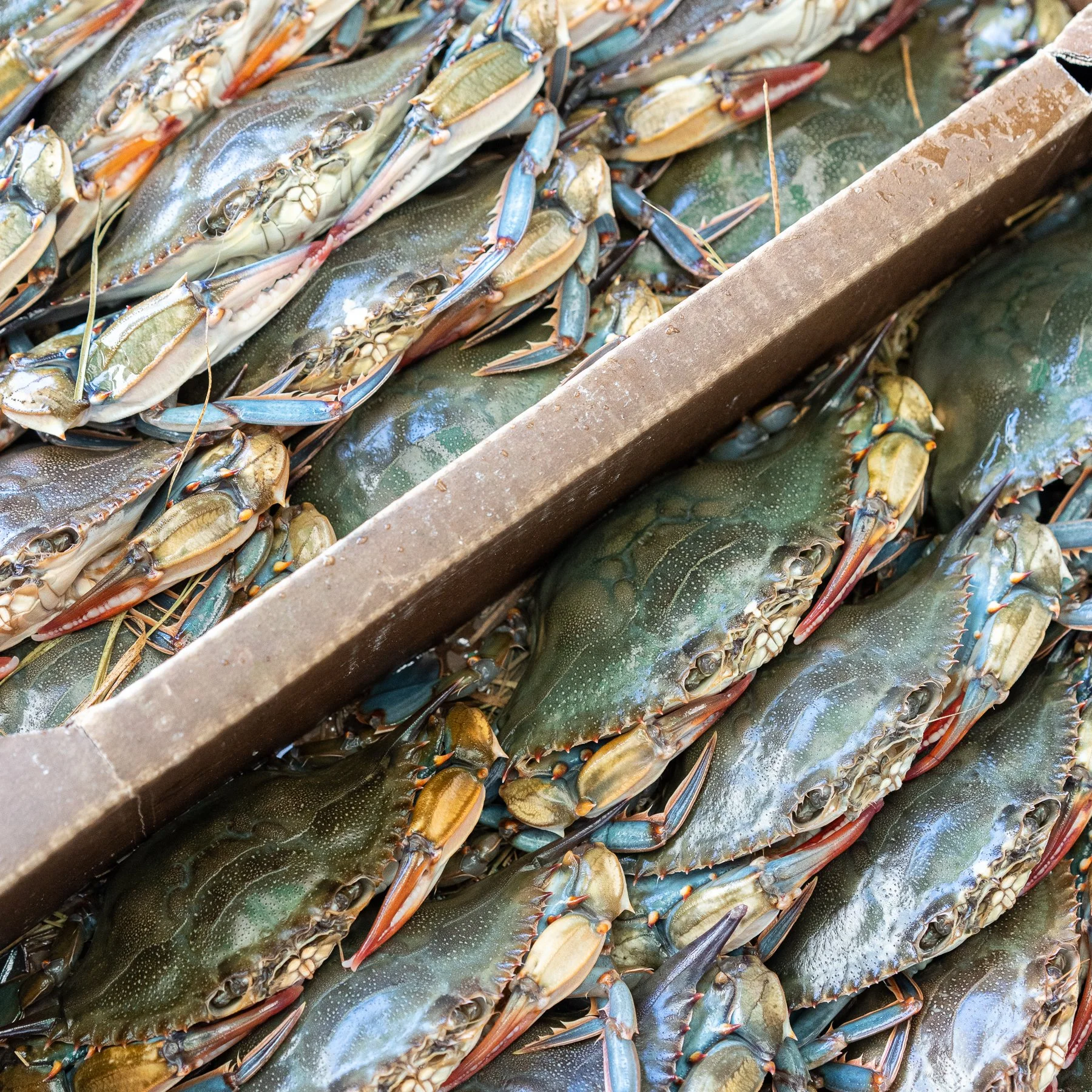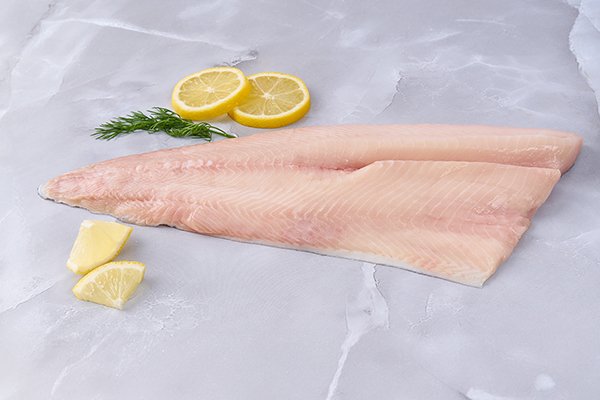Our Seafoods
Here is a selection of the fish and seafood we offer throughout the seasons.
These seafoods are locally sourced and/or come from fair and sustainable fishing or farming practices.
What’s in Season
SUMMER
BLACK SEA BASS
Black sea bass that is firm yet tender, and has a mild, fresh, delicate flavor, similar in flavor to a Red Snapper. It’s a great choice if you're trying to eat healthy, as it is a good source of naturally low-fat protein and magnesium.
FUN FACT: Black sea bass appear bluer underwater but lose this color when out of water.
BLUEFISH
The bluefish is a large, long fish with a greenish-blue body and a forked tail. It visits the Chesapeake Bay’s open waters from spring through autumn. Wild caught, saltwater fish with a rich fish flavor, and oily meat.
FUN FACT: Bluefish can live for more than 12 years.
cod
Their flesh is an opaque white, pink tinged color when raw and remains white after cooking. Cod have a lean, mild flavor profile with large flakes and a tender-firm texture. Atlantic Cod are a little sweeter than Pacific Cod. Both are less firm and less sweet tasting compared to Haddock.
FUN FACT: Cod fishes communicate with each other by making sounds using drumming muscles.
soft SHELL crab
Soft shell crab is a culinary delicacy that consists of a crab that has recently molted its old exoskeleton, leaving behind a soft and pliable shell. During this molting process, the crab's shell becomes paper-thin and can be eaten in its entirety, including the legs and body. The soft shell crab is often prized for its tender texture and sweet, succulent flavor.
FUN FACT: Soft-shell crabs are actually regular crabs that have been caught just after molting their hard shell, making them entirely edible.
flounder
Flounder has a mild creamy and buttery taste with notes of sweetness. It has a delicate texture similar to tilapia and halibut and is ideal for baking and adding to soups, casseroles, and salads. Flounder tastes a lot like salmon, but it’s a little bit leaner in terms of fat content and has a more milder flavor.
FUN FACT: Color of the body also indicates emotional state of the flounder. Threatened animals are usually pale-colored.
grouper
Grouper has a firm meat with large flakes. It’s lean and moist, with mild flavor often described as a cross between Bass and Halibut.
FUN FACT: There are over 100 different species of grouper, with the largest being the Goliath grouper, which can grow up to 8 feet long and weigh over 800 pounds.
haddock
Haddock are a northern Atlantic fish which are related to Cod yet are distinctly different. They have a mildly sweet taste with lean white flesh and medium flakes with a texture which is firm yet tender after cooking.
FUN FACT: Haddock can live for about 10 years in the wild.
hake
A member of the cod family, is known for its mild and slightly sweet flavor. It has a light, flaky, and tender texture, making it a versatile ingredient in various cooking methods.
FUN FACT: Hake is very swift fish with huge appetite. Researchers once discovered 75 herrings in the stomach of a captured hake.
halibut
Halibut has white flesh, large flakes and a firm but tender texture. It is a lean fish with mild, sweet tasting flesh. Because of its leanness, this fish becomes dried-out if overcooked.
FUN FACT: The name "halibut" comes from the Middle English term "halybutte," meaning "holy flatfish."
mahi mahi
Mahi Mahi has a mild, sweet flavor that is often compared to the taste of swordfish. Its flesh is firm and has a slightly meaty texture, making it a popular choice for grilling. The fish has a low oil content, which means that it does not have a strong fishy taste like some other types of fish.
FUN FACT: Mahi-mahi are known for their vivid colors, including blue, green, and gold, with iridescent scales that reflect light.
redfish
Redfish has a mild and sweet taste, making it versatile for various cooking methods. The meat has a buttery flavor and a medium-firm texture, appearing creamy-white when raw and turning a smooth, light gold when cooked.
FUN FACT: They can live up to 40 years and are considered mature at around 6 years.
salmon
Salmon has a mild, yet distinct flavor that is often described as buttery, rich, and slightly sweet.
FUN FACT: Salmon are anadromous, meaning they are born in freshwater, migrate to the ocean to mature, and then return to freshwater to spawn. This remarkable journey can cover hundreds of miles.
shark
This fish is well known for its slightly firm texture, similar to Swordfish, with a mild flavor and very moist meat, which makes it perfect for new and experienced fish lovers.
FUN FACT: Thresher sharks are named after their tail: The name "thresher" comes from the Greek word ἀλώπηξ, meaning fox, due to their long, fox-like tail used for hunting.
shrimp
Delicately sweet, with briny undertones, and umami richness. Shrimp’s texture also plays a significant role in its overall flavor experience.
FUN FACT: Shrimp possess some of the most complex visual systems in the animal kingdom. They can see ultraviolet light and have a 360-degree field of vision due to their compound eyes.
spanish mackerel
Spanish mackerel boasts a distinct and flavorful taste, offering a richer, more pronounced fishy flavor than milder white fish varieties. Its oily flesh provides a satisfyingly smooth texture, making it a popular choice for grilling, smoking, and pan-searing when prepared correctly.
FUN FACT: Spanish mackerel can swim incredibly fast, reaching speeds of up to 18 feet per second.
squid
Squid offers a unique taste that combines sweetness with a hint of brininess. It has a mild, slightly earthy flavor that is reminiscent of the ocean. The taste can vary depending on the cooking method and the seasoning used, but squid generally has a delicate and enjoyable flavor.
FUN FACT: Squids are fascinating creatures with impressive abilities like changing color, communicating through chromatophores, and regenerating lost limbs.
striped bass
Striped Bass has a mild flavor profile that is somewhat similar to cod or halibut. It has a slightly sweet taste and a flavor that is best described as buttery. Its texture is firm but flaky. Striped bass doesn’t taste fishy, so people who do not fancy fish can give it a try.
FUN FACT: They were a staple food for the Pilgrims during the early days of the Plymouth Colony, often referred to as "the fish that fed Plymouth".
swordfish
Swordfish has a mildly sweet flavor and a moist, meaty texture with moderately high fat content. The flesh can range from white or ivory to pink or orange. The color variations do not reflect quality. All Swordfish turn beige in color after cooking.
FUN FACT: The swordfish's most distinctive feature is its long, flat bill, which resembles a sword. This bill is not just for show; swordfish use it to slash at their prey.
tuna
Tuna offers a rich and diverse flavor profile that varies significantly among its different species, making it a versatile choice for various culinary applications. It has a very firm, meaty texture and a medium-mild flavor.
FUN FACT: Unlike most fish, Tuna is a warm-blooded fish, which allows them to engage their muscles quickly to either flee danger or attack prey.
WINTER
hard shell clams
Hard clams, also known as quahogs, have a thick, strong shell and are commonly found along the East Coast of North America. They are popular in cooking, especially for chowders and clams casino.
FUN FACT: Hard clams can live up to 40 years or more! Some of the oldest have been found to be over 100 years old.
soft shell clams
Often called steamers, these clams have a thinner, more delicate shell compared to hard clams. They are known for their sweet, tender meat and are great for steaming and dipping in butter.
FUN FACT: Soft clams are known for their ability to "dig" into the sand using their foot, which can be up to 8 inches long!
FLUKE
Also known as summer flounder, Fluke is a flatfish found along the Atlantic Coast of North America. It has a distinct flattened body with both eyes on one side, which helps it blend into the sandy ocean floor. Fluke are prized for their mild, delicate flavor and firm texture.
FUN FACT: Fluke are capable of changing the color of their skin to match their environment, helping them camouflage perfectly on the ocean floor to avoid predators.
monkfish
This wild caught, saltwater fish has a mildly sweet taste and a firm, dense texture.
FUN FACT: They have been a staple of European cooking for a long time, but lately popular in other parts of the world.
mussels
Commonly found in both saltwater and freshwater environments, mussels have a smooth, oblong shell that can range in color from black to blue or green. Mussels are often cultivated in beds and are a popular seafood choice for dishes like mussels in garlic butter or steamed mussels with white wine.
FUN FACT: Mussels can "stick" to surfaces using byssal threads, which are strong, silk-like fibers that they secrete, allowing them to stay anchored to rocks or piers even in strong currents!
oysters
Oysters are bivalve mollusks that live in both saltwater and brackish environments. Oysters are famous for their rich, briny flavor, and they are often enjoyed raw, on the half shell, or cooked in various dishes.
FUN FACT: Oysters can filter up to 50 gallons of water a day, helping to improve water quality in their environment by removing plankton, algae, and other particles!
Rainbow Trout
This freshwater fish is farm raised, and has a fine flaked and delicate texture with a very mild flavor.
FUN FACT: They always try to return to the same part of the river where they were hatched. Trout is part of the Salmon family.
Bay Scallops
Scallops are wild caught in saltwater and have a firm and velvety texture with a sweet and rich flavor, that can range from mild to briny.
FUN FACT: Since their abductor muscle is not used to filter water, they’re less susceptible to toxins or contaminants.
sea urchin
These spiny, spherical marine creatures have hard, globular shells called "tests," which are covered in sharp spines for protection. Sea urchins are known for their delicate, sweet, and briny roe, often considered a delicacy, especially in sushi dishes.
FUN FACT: Sea urchins have five "teeth" arranged in a circular pattern inside their mouths, known as Aristotle's lantern, which they use to scrape algae off rocks and crush food!
shad
Shad are migratory fish found in rivers along the East Coast of North America, often known for their distinct, silvery appearance. They have a rich history in fisheries, especially for their roe, which is considered a delicacy.
FUN FACT: Shad are known for their incredible migration journey, traveling from the ocean to freshwater rivers to spawn. Some shad travel hundreds of miles during their spawning season!
SKATE
This wild caught, saltwater fish has a firm flesh and a high collagen content which gives it a unique texture when cooked. Skate fish have a mildly pronounced flavor, similar to scallops.
FUN FACT: They are shaped like a kite and although colors vary, most Skate are a brownish-gray color. Skates are larger than Rays and have longer, more pointed snouts.
snapper
Snapper is a wild caught, saltwater, lean fish with a firm texture and medium flakes.
It has a distinctive mild, lean, sweet, nutty flavor which makes it versatile for many flavor components from mild to intense seasoning.
FUN FACT: Despite their typical association to Florida, this species can be found from Massachusetts to Brazil.
stone crab claws
Stone crabs are found in the warm waters of the Gulf of Mexico and the Atlantic Ocean. They are known for their large, meaty claws, which are prized for their sweet, tender meat. Unlike most crabs, only the claws are harvested; the crab is released back into the wild to regenerate new claws. This sustainable harvesting method helps maintain their population.
FUN FACT: Stone crabs can regenerate their claws after they’re harvested, which means they can grow back even larger claws in subsequent seasons!
TILE FISH
Tilefish are vibrant, deep-water fish found in the Atlantic Ocean, known for their firm, white flesh and mild, sweet flavor. They are often found in rocky, sandy ocean floors, where they burrow and create dens. Tilefish are popular in seafood dishes like fish tacos, grilled fillets, and chowders.
FUN FACT: Tilefish are sometimes called "the lobster of the Gulf" because of their sweet, lobster-like taste, and they are known for living in "homes" they create on the ocean floor!
YELLOWTAIL
Yellowtail is a popular name for various species of fish, most notably the Japanese amberjack (Seriola quinqueradiata). Found in warm waters of the Pacific and Indian Oceans, yellowtail is known for its firm, flaky texture and mild, slightly sweet flavor. It's a favorite in sushi, sashimi, and grilled dishes.
FUN FACT: Yellowtail fish are known for their strong swimming ability and can reach speeds of up to 40 miles per hour!


































